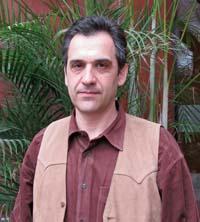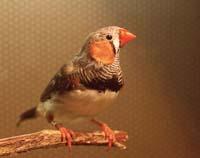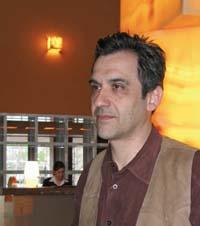Juan Uriagereka: "I believe that thought participates in the conversion of words of the FOXP2 gene"

That is. Thus, we began to bring together several people interested in the subject of human, or animal intelligence. We want to know what intelligence is, in short, it is a natural phenomenon that allows us to have this dialogue or adapt to complex societies. We come from several fields: some are philosophers, others are computer scientists, others are biochemists, neurologists, etc.
It is a very beautiful story. About fifteen years ago a family with a disease known as language specific disorder was found in London. These people have great difficulty speaking, not just speaking, understanding complex sentences, repeating long words, etc.

They observed that for three generations of this family the disease had passed mainly by the mother, following the traditional model of inheritance of Mendel. Then they realized that the disease had a certain genetic basis.
Soon after they were very lucky, as they found another friend with a similar syndrome outside this family. When analyzing their genome, they saw that on a chromosome there was a translocation, that is, that had changed the code of the genes. At that time these two genomes were compared and in a few weeks the gene was discovered.
At first they thought it was a new gene (called speech 1, because it was the language gene). But when they analyzed it in more detail, they saw that he was a member of a family of regulatory genes, the FoxP family. These genes are transcription factors, that is, they start other genes. Today we know that FOXP2 affects 285 genera.
Of course, once the gene has been found, it is now necessary to do a lot of work, to know what has seemed to them, in what tissues it is expressed, what functions it has in human behavior and other species, etc. And I can say that every week they publish a new article about this gene.
All right, the truth. In general, I only see progress. Now, in addition, they have found it in a lot of species: mice, birds in English called zebra finch ( Taeniopygia guttata), various fish, yeasts... It is everywhere.
The example of birds is very beautiful. The gene is expressed in two situations in his brain: one, when the birds are learning a song (the first two months of his birth they learn to sing; if then they do not listen to the song, they do not learn); and another, when the male bird is singing to the female. However, when the bird sings on its own, the gene expression decreases greatly. This is very beautiful, which will allow us to see for the first time how the regulation of an already identified gene and a specific behavior (in this case singing) are associated.

This means that the gene has a necessary function in the language, but that in no case is enough. That is why I tell you that it is not the gene of language, but a necessary gene in that great puzzle.
Now we need to understand what function that gene has exactly in that puzzle. In birds, at least, it is very curious because it seems that it is regulating the singing. Imagine that birds separated from us 320 million years ago, we are very different evolutively. And it seems that the gene has a fairly similar function in both. The bird must translate a brain structure (we don't know what it is) and turn it into a song we hear.
Yes, it is very important. To begin with, this gene has about 625,000 bases, is giant, also large among the big genes. The protein that encodes it, with 715 amino acids, is very similar in all animals: only three amino acids are different from those of the mouse, and only two compared to chimpanzees. It is curious because we separated from the mouse 75 million years ago and from the chimpanzees about 6 million years ago.
This is the part that encodes the protein. Well, gene introns -- the rest of the gene -- have varied very little in evolution; many parts are identical in many species. This means that the gene has a very basic function and therefore has maintained its structure for so many millions of years. It is clear that this function cannot be speech.

I believe (that is my bet) that in terms of language, the gene participates in the transformation of thought into words. For example, I do not doubt that chimpanzees have complex thoughts, but somehow they are chained in the head of chimpanzees, they cannot express themselves like us, they have no expressions. However, today we do not know if it is true.
It refers to Bob Berwick, a person who is very useful in this great debate. He is a computer scientist and biologist and one of the most knowledgeable of this gene. Bob wants to stress that we don't really know what's going on with that gene.
On the other hand, they have seen (because they have been genetically modified) that zebra finch birds have great difficulty learning singing when that gene is knock down. This means that it is more than one printer. In computer terms, I think the FOXP2 gene would be a program that takes information from the operating system to the screen. It may just be that, but if it fails, you can't see anything on the screen.
However, all this is just a bet, we have not shown it. We would have to do an experiment currently prohibited to see what really happens.
Now I will answer a more general question, how many are being discussed on this subject. As for mutations, it cannot be discussed, they have been found and nothing can be said. Nor can we argue that the gene is regulator and that it appears in many species. Discussions and doubts arise when interpreting. There are several ideas. For example, the one most heard lately says that the gene is regulating something in the movement system.
However, I think the idea is wrong, considering what they saw in the experiment they did in the birds. The birds have two very well defined behaviors: in one they sing the female and in the other they only sing (the songs are called directed and not directed respectively). In both cases, the birds perform the same movements, as they are singing in both. And the gene is activated in the first and disabled in the second.

I come from the world of syntax, I am one of those boring linguists who study, among others, trees, relationships between words and differences between active and passive phrases.
The point is that I have always wanted to go beyond those structures. It has always struck me to know how the brain is able to develop these structures, what kind of memory it has, etc.
That is why I have started working with people outside of linguistics (philosophers, biologists, computer scientists, etc. ). Among all, we try to combine the languages and terms that are used in each area to understand us. So, we have started looking for things: on the one hand we have the biochemical components that intervene, on the other, the genes, the neurological circuits... it is a great puzzle.
My colleagues and I try to make the models we study become measurable parameters for people working in neurology, genetics, etc. For example, if you look at a phrase, you see an object. From my point of view, it is a process, a process with several sections. Thus, we try to see how this process is reflected in the brain.

That is. Of course, we have to be very cautious about it, because we have a big problem: when a gene is expressed, the events associated with that expression last several days, weeks, while the dialogue we are having now is being processed at a speed of milliseconds. We lack the connection between both facts.
This is one of the great challenges we have now: we want to understand the function that the FOXP2 gene can have at every moment we speak. I think there's a protein (or a group of proteins) that connects and disconnects at high speed in some way we don't know yet. As long as, of course, there is gender in all this!
Well, after all we are all scientists and we want to understand how things work. And in that endeavor we sometimes have to learn new things...
Buletina
Bidali zure helbide elektronikoa eta jaso asteroko buletina zure sarrera-ontzian











